VAC AERO vacuum furnaces are used in every aspect of thermal processing in a multitude of industries including; Commercial heat treatment, Aerospace and engine parts, Medical implants, Nuclear tubes, Tool and Die, and most recently in Additive manufacturing. Vacuum processes are equally diverse, from brazing of aerospace components and hardening of stainless and tool steel dies to annealing of zirconium tubes and case hardening of power transmission components
Vertical vacuum furnaces combine fast cycle times and quenching speeds to provide better uniformity of large production parts with complex geometries and are ideal for processing large circular parts such as rings, stators or engine casings and long parts like shafts or rolls.
CLICK HERE for Standard Furnaces Sizes
The standard VAV Series Vertical, Bottom-loading, Vacuum Heat Treating, and Brazing Furnace can be customized to suit unique applications such as high-pressure gas quenching, high-temperature heat treating, ultra-clean processing and more.
The furnace is designed to have fast heating rates to very uniform temperatures at high vacuum levels. Standard units are equipped with a gas quench system capable of cooling the load rapidly from processing temperatures at quench pressures up to two bar.
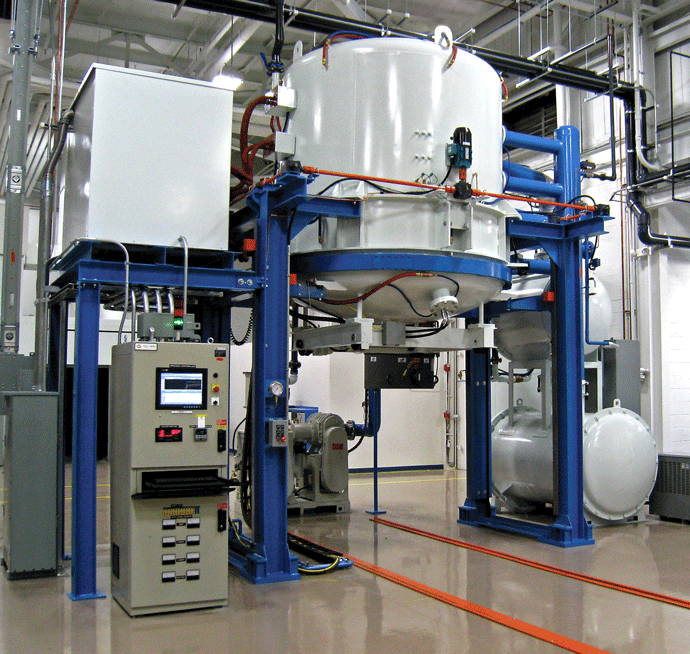
Advanced microprocessor controls are used exclusively to ensure precise control and repeatability. VAC AERO control systems can be integrated with internal networks and offer extensive data collection capabilities. VAC AERO also manufactures auxiliary equipment for quench gas storage and furnace cooling requirements.
CLICK HERE TO SEND US AN RFQ FOR A VERTICAL VACUUM FURNACE
CLICK HERE TO VIEW MORE DETAILED VACUUM FURNACE PRODUCTION SPECIFICATIONS
VAC AERO Vacuum Gas Quench Furnace features and capabilities include:
- Operating temperatures up to 2400°F (1315°C).
- Ultimate vacuum levels in the 10-6 torr range.
- Modular hot zone design for easy maintenance.
- All-metal hot zones are available for ultra-high vacuum processing and critical cleanliness part processing.
- Alternatively, economical graphite-based insulation provides extended durability.
- Heating elements available in lightweight curved graphite or molybdenum strip.
- Selectable gas quench pressures from 2 bar to 10 bar.
- Fully automated control systems including PC-based controls with remote access.
- Optional convection heating capability.
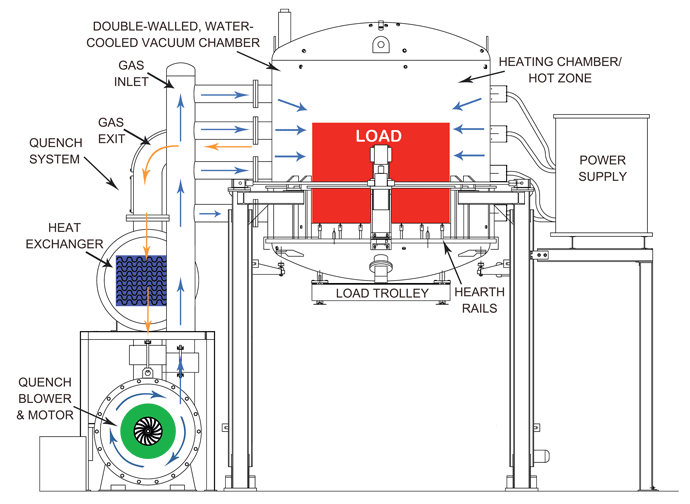
FEATURES:
Our vertical bottom-loading vacuum furnaces are primed and painted the customer’s choice of color and include a double-wall vessel, hot zone, gas cooling system, control (operating) system, power supply, and water-cooling system. Briefly, these features are summarized below:
HOT ZONE:
VAC AERO hot zones have unitized construction for easy removal and maintenance and lightweight design with low thermal mass and inertia for faster quenching and long life. There are no load transfer mechanisms within the hot zone and few to no moving parts. Temperature control can be based on either the furnace control thermocouple, load thermocouples or both.
- Work Load Size: Standard sizes up to 84” diameter x 84″ high. Larger models are also available.
- Heating Elements: Customer’s choice of lightweight curved graphite, pure or lanthanated molybdenum strip.
- Hearth: Constructed with quickly removable hearth rails of pure molybdenum designed to support uniformly distributed loads up to 4000 lbs at 2400°F.
Radiation Shields: (Graphite-based Construction):
The standard graphite-based insulation package normally consists of three or more layers of carbon felt with an inner facing of graphite foil bonded carbon composite for added protection and enhanced reflectivity. The heat shield package is supported by a stainless steel support structure that also acts as a manifold to distribute the quenching gas uniformly throughout the workload in a 360º pattern.
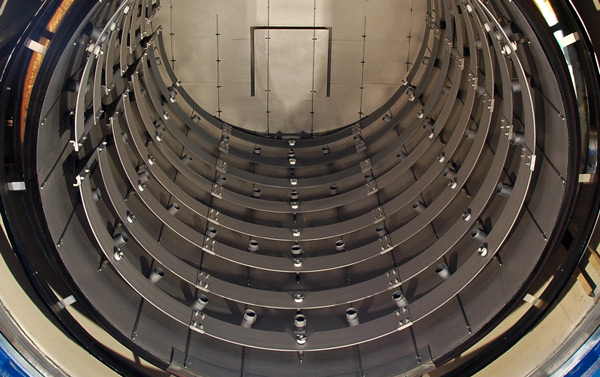
Radiation Shields (All-Metal Construction):
For ultra-clean processing applications in industries such as aerospace and medical, the use of an all-metal hot zone construction is commonplace. The standard all-metal insulation package consists of two layers of pure molybdenum sheet backed by three layers of stainless steel sheet. The heat shield package is supported by a stainless steel assembly that also acts as a manifold to distribute the quenching gas uniformly throughout the workload.
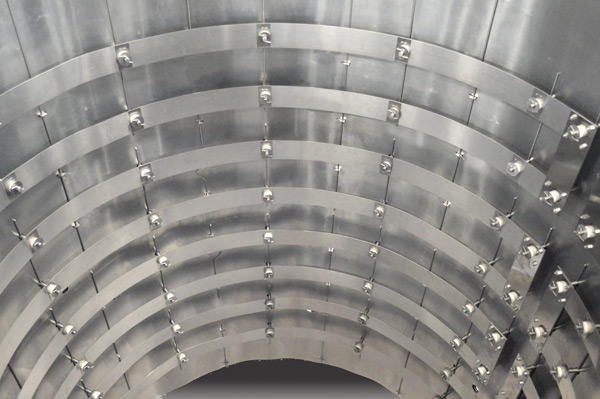
FURNACE CHAMBER:
The furnace chamber, as well as the upper and lower heads, are a double-wall, water-cooled design, with space between the walls for circulation of coolant. Internal stiffeners are positioned between the walls for added strength. The chamber is equipped with all necessary thermocouple jacks, gauge ports, pumping ports and gas quench entries located for both functionality and easy maintenance access.
The load is stationary throughout the cycle, being orientated and positioned in the furnace prior to closing the door. The tank assembly is vertically aligned with a bottom opening load head. The bottom head along with the load is raised and lowered at a constant speed in a smooth continuous motion by ball screw-driven lifting jacks. Once lowered, the bottom head rolls out from beneath the furnace by means of a powered drive assembly to allow complete (360°) access to the load. The vessel is equipped with a powered rotary clamping system to secure the bottom head during processing (Fig. 2). A “ground fault” system is normally supplied to detect if the load or fixtures touch the heating elements during loading or unloading and will stop the elevator to prevent damage.
Temperature uniformity can be precisely determined at any point in the chamber, which will remain constant unless equipment induced variability is introduced. This testing is accomplished using a stationary survey rack.
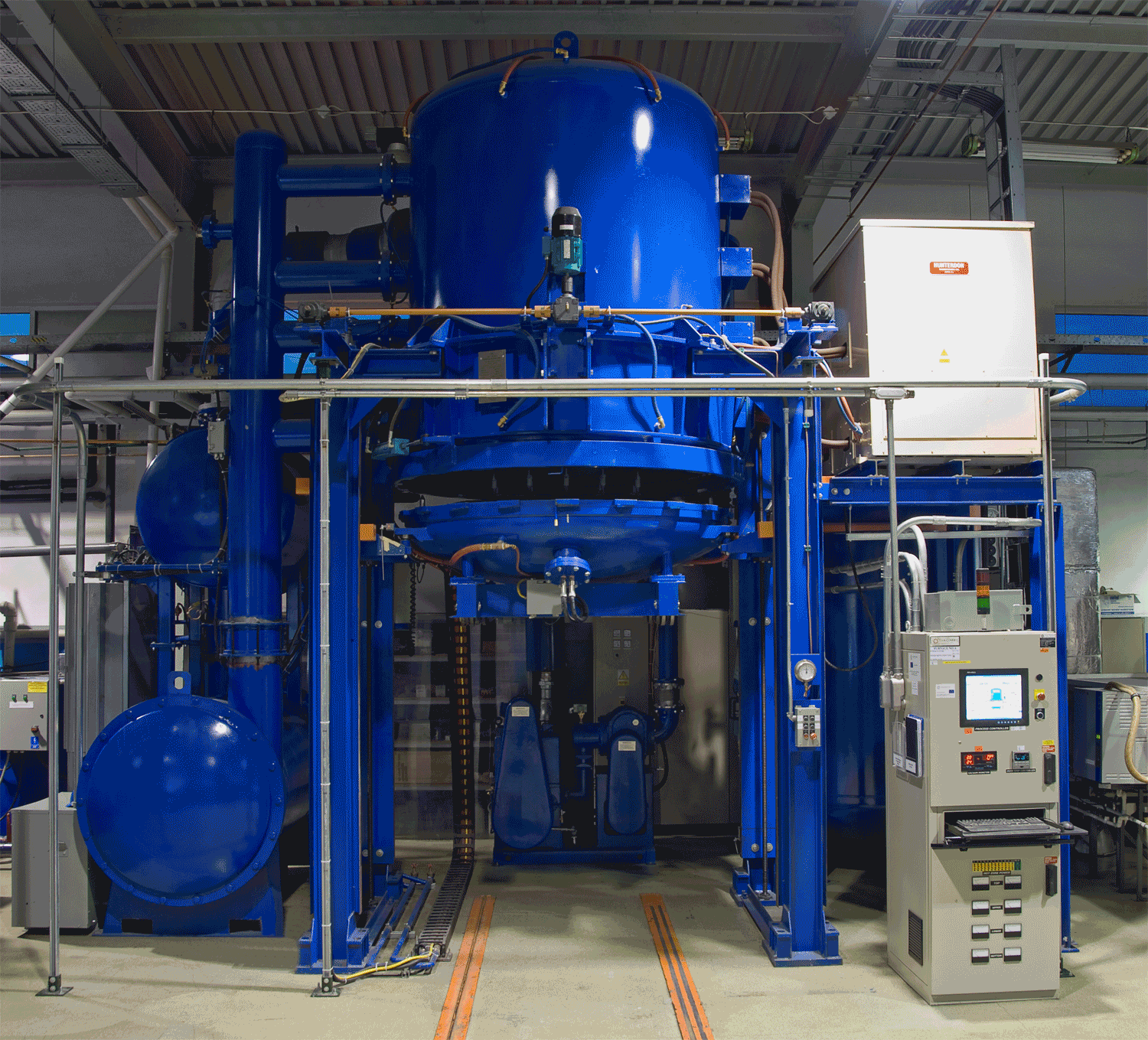
VACUUM PUMPING SYSTEM:
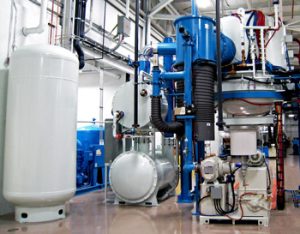
The vacuum pumpdown is automatic and interlocked. The VAC AERO design uses a holding pump to maintain a low pressure on the diffusion pump foreline at all times. This feature, combined with proper timed sequencing of vacuum valves, virtually eliminates backstreaming of pump oils.
The vacuum pumping system will vary depending on the application and the desired operating vacuum level for a given material and process cycle. Many furnaces operate in the “soft vacuum” range (low micron level) where a mechanical pump or mechanical pump/blower type system provides an adequate vacuum level. Other furnaces are built to operate in the “high vacuum range” (typically 105 to 10-6 Torr) and utilize a diffusion or turbo-molecular pumping system.
In operation, vacuum pumpdown is automatic and interlocked. A holding pump is used to maintain a low pressure on the diffusion pump foreline at all times. This feature, combined with proper timed sequencing of vacuum valves, avoids backstreaming of pump oils. This feature, combined with proper timed sequencing of vacuum valves, avoids backstreaming of pump oils into the chamber.
The basic features of a good vacuum pumping system include:
- Mechanical Pump: Roughing Pump and Booster combination appropriately sized for furnace volume.
- Diffusion Pump: Varian series complete with a charge of Dow Corning fluid.
- Holding Pump: Rotary vane pump.
- Main, Roughing and Foreline Valves: Right angle poppet valve with electropneumatic operation.
- Partial Pressure Capabilities: The furnace can be operated at partial pressures up to 1 torr (1000 microns) of inert gas (argon or nitrogen, whichever is used for quenching). A failsafe hydrogen partial pressure system is also available (optional).
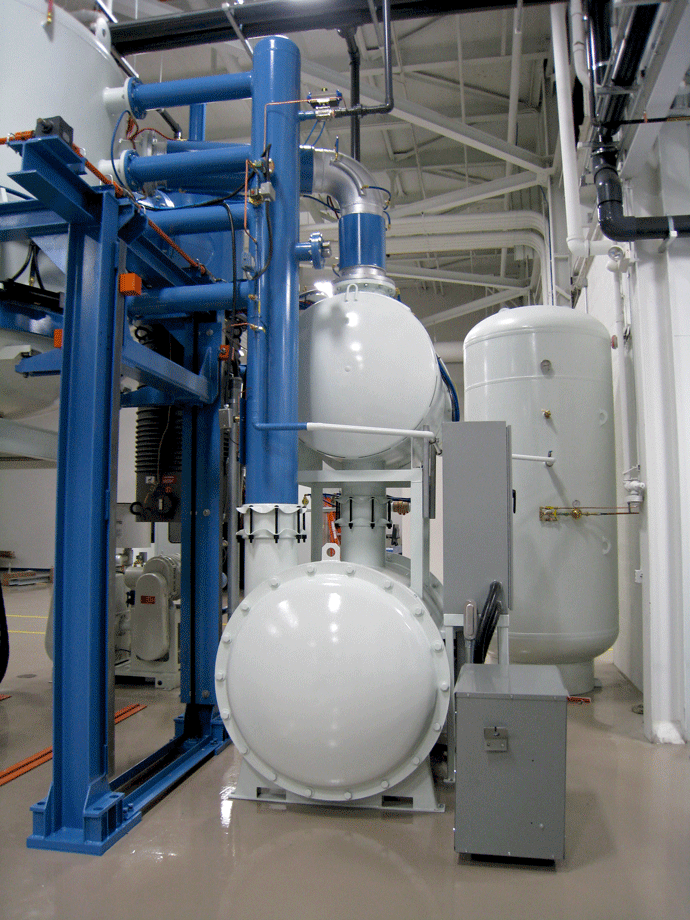
VAC AERO’s IG Series Quench Gas Storage Systems are available as an option.
A vertical vacuum furnace with gas quenching capability normally incorporates an external gas recirculating system to cool the inert quench gas used to extract heat from the load at the completion of the heating cycle. The type of cooling gas and gas pressure can be varied during a given cycle to accommodate the materials being processed or properties (metallurgical, mechanical, etc.) desired. Depending on the application, the cooling gas is introduced into the chamber from sub-atmospheric pressure or, for fast quenching, at pressures up to 10 bar. The cooling gas is normally recycled through a heat exchanger and blower system, which can be either internal or external to the chamber.
An external recirculating inert gas quenching system distributes quench gas through circumferentially located internal nozzles for rapid, uniform cooling of the workload. The system includes:
- Quench blower powered by an electric motor with soft start.
- Special high-efficiency tube/fin heat exchanger.
- Complete quench piping.
- Selectable operating pressure.
PROCESS CONTROLS with SCADA:
The VAC AERO control system is programmable and logic based. Our design philosophy is to simplify control by using the program capabilities to perform as many functions as possible, thereby reducing operator dependence. VAC AERO has also chosen proven hardware components, suitably hardened for an “industrial shop” environment.
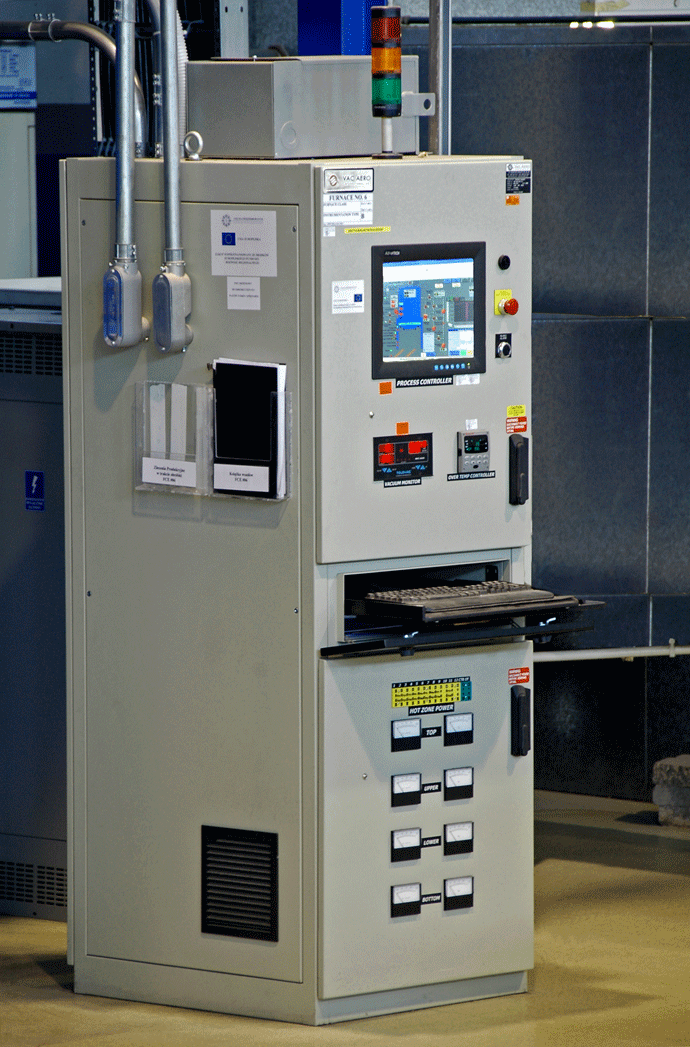
Furnace controls, instruments, and monitoring systems are normally enclosed in a NEMA 12 control cabinet. The system uses a state-of-the-art Hybrid controller to control the machine functions and furnace temperature. The controller integrates with software running on a personal computer to provide Supervisory Control and Data Acquisition (SCADA).
An operator interface is provided through an LCD touch-screen mounted in a control panel. An extensive range of standard displays is available. Often the operator will program and monitor furnace operation from the unit while the operation is supervised from a remote location during the cycle.
Each load has its own unique and often preprogrammed recipe to control such process variables as ramp rates (heating & cooling), preheat temperatures and times, final process temperature and time, ultimate vacuum level, partial pressure setpoints and quench gas pressure to name a few.
Key features & benefits of VAC AERO’s Process Controller:
- Compatible with plant-wide SCADA and network integration.
- Process cycle validation.
- Extensive alarm and event management and reporting.
- Temperature control using advanced algorithms, auto-tuning, and multiple PID loops.
- Operator sign-on/sign-off security provides up to 255 control levels to limit operator control of individual items of plant and equipment.
- Enhanced maintenance and troubleshooting management and trending.
Vacuum Instrumentation:
A Vacuum Gauge Controller with 2 station, thermocouple gauge and 1 station Penning (cold cathode) gauge is used to monitor the chamber and the pumping system. This instrument is integrated with the process controller to provide dedicated setpoints that control all critical vacuum-related process functions.
Overtemperature Safety Controller:
Digital manual set 0°F – 3100°F, Type S.
Power Supply:
The power supply used to provide power to the heating elements can be of two different types. These commonly are either a silicon controlled rectifier (SCR) or a water-cooled variable reactance transformer (VRT). Each VRT has a 0 – 100% trim control for optimum temperature uniformity in the hot zone. To save floor space, the power pack is often mounted on top of the furnace The heating element power is supplied by an A.C. water cooled power supply containing single-phase VRT assemblies. Each VRT has a 0 – 100% trim control for optimum temperature uniformity in the hot zone.
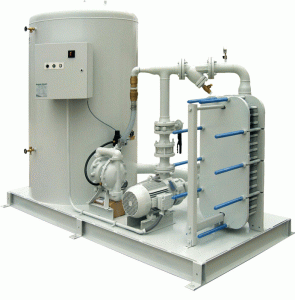
The furnace water system consists of a compact manifold containing all necessary pressure regulators, valves, pressure switches and flow regulators with supply and drain hoses and fittings. As an option, VAC AERO can provide a Dual Loop Cooling System to supply coolant to the furnace.
INSTALLATION AND START-UP ASSISTANCE
The system is shipped complete, tested and ready for installation. VAC AERO offers installation supervision or complete installation services. After installation, a qualified VAC AERO technician will visit the site to commission the equipment and provide instruction in furnace operation. As part of every furnace contract, VAC AERO also provides pre-delivery training in heat treating processes furnace operation and maintenance.
VAC AERO’s vertical gas quench vacuum furnaces offer the industry a robust, cost-effective and highly functional design, capable of a processing a wide variety of products under highly controlled conditions to demanding quality standards.
